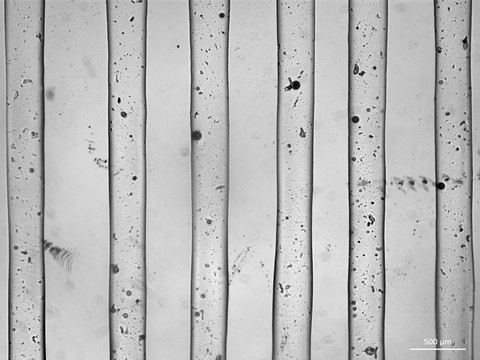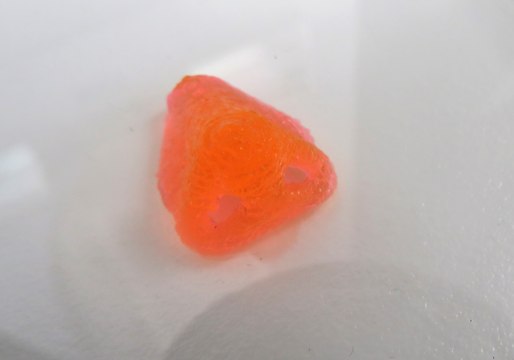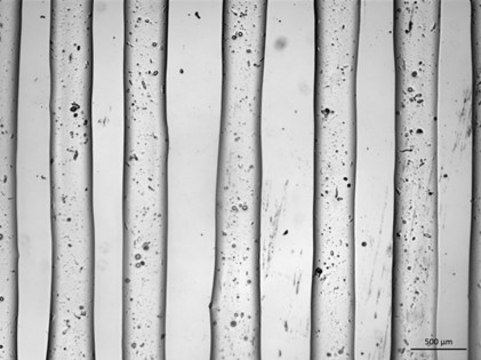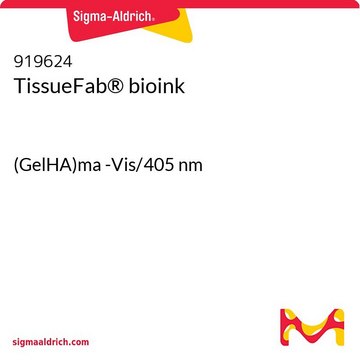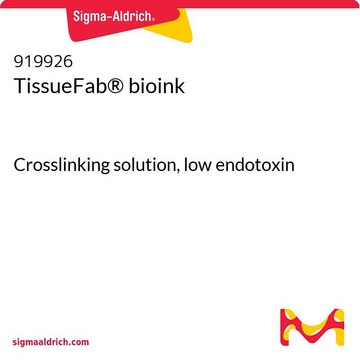推荐产品
描述
0.2 μm sterile filtered
suitable for 3D bioprinting applications
表单
viscous liquid
杂质
≤5 CFU/g Bioburden (Fungal)
≤5 CFU/g Bioburden (Total Aerobic)
颜色
colorless to pale yellow
pH值(酸碱度)
6.5-7.5
应用
3D bioprinting
储存温度
2-8°C
正在寻找类似产品? 访问 产品对比指南
一般描述
应用
包装
其他说明
- Optimize printing conditions (e.g., nozzle diameter, printing speed, printing pressure, temperature, cell density) for the features of your 3D printer and your application.
- Reduce bubble formation. Air bubbles in bioink may hamper bioprinting. Carefully handle the bioink when you mix and transfer it to avoid bubble formation. Do not vortex or shake vigorously.
Procedure
1. Prepare bioink: Keep TissueFab® - Sacrificial Bioink on ice to prevent gelation and gently invert the bioink to make a homogeneous solution. DO NOT vortex or shake vigorously. Transfer TissueFab® - Sacrificial Bioink into the desired printer cartridge.
2. Bioprint: Warm TissueFab® - Sacrificial Bioink in the printer cartridge to room temperature for 10–15 minutes to induce gelation. Follow the 3D printer manufacturer′s instructions. Load the print cartridge onto the 3D printer and print directly onto a Petri dish or into multi-well plates. Adjust the flow according to nozzle diameter, printing speed, printing pressure, and temperature. TissueFab® - Sacrificial Bioink can be printed in tandem with cell laden bioinks using additional printheads.
3. Optional Crosslink: If additional bioinks are used, crosslink the bioprinted structure before removing sacrificial scaffold following bioink instructions.
4. Remove sacrificial scaffold: Cool printed structure to 4 °C for at least 5 minutes. Rinse or perfuse with cold PBS.
5. Culture cells: Culture the bioprinted tissue with appropriate cell culture medium following standard tissue culture procedures.
法律信息
储存分类代码
10 - Combustible liquids
WGK
WGK 1
法规信息
商品
生物墨水可3D生物打印形成功能组织结构,从而应用于药物筛选、疾病建模和体外移植。针对特定组织工程应用选择生物墨水和打印方法。
Bioinks enable 3D bioprinting of tissue constructs for drug screening and transplantation; select suitable bioinks for specific tissue engineering.
Learn how 3D bioprinting is revolutionizing drug discovery with highly-controllable cell co-culture, printable biomaterials, and its potential to simulate tissues and organs. This review paper also compares 3D bioprinting to other advanced biomimetic techniques such as organoids and organ chips.
Professor Shrike Zhang (Harvard Medical School, USA) discusses advances in 3D-bioprinted tissue models for in vitro drug testing, reviews bioink selections, and provides application examples of 3D bioprinting in tissue model biofabrication.
实验方案
Frequently asked questions (FAQs) for KAPA SYBR® FAST One-Step qRT-PCR Kits.
我们的科学家团队拥有各种研究领域经验,包括生命科学、材料科学、化学合成、色谱、分析及许多其他领域.
联系客户支持